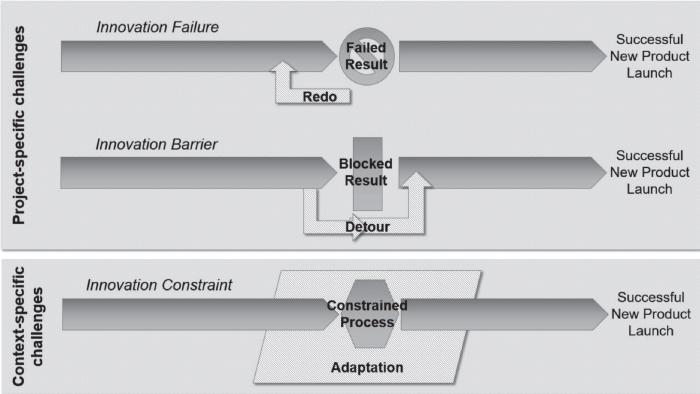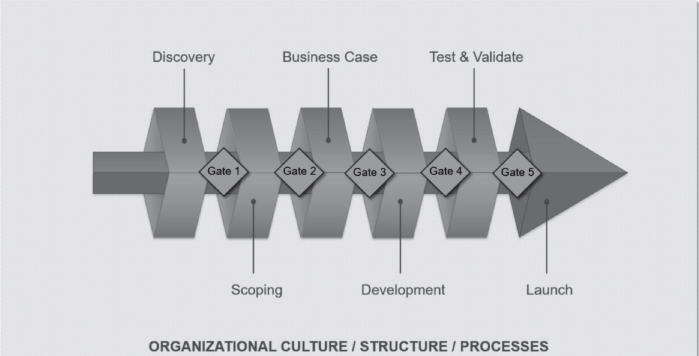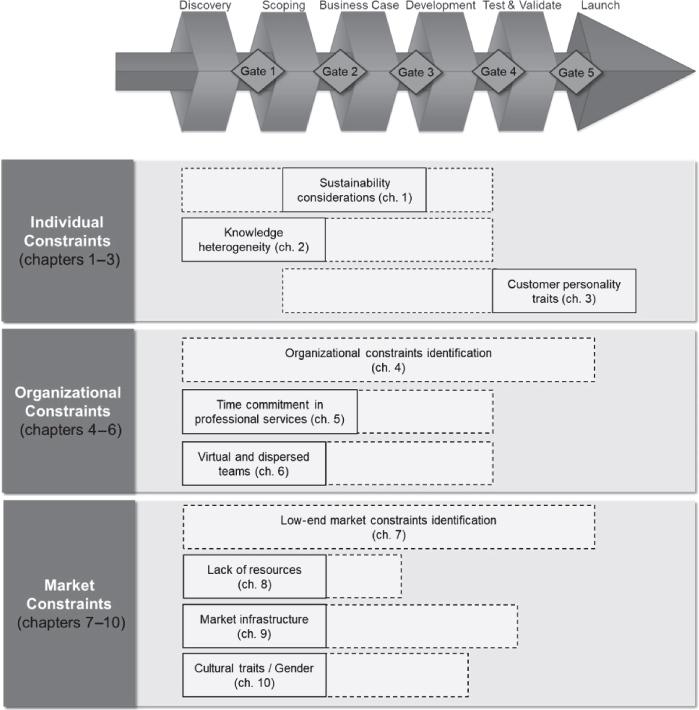INTRODUCTION
Jelena Spanjol
Professor and Head, Institute for Innovation Management, Munich School of Management, Ludwig-Maximilians-Universität, Munich, Germany
Sebastian Gurtner
Professor of Health Care Management, Strategy & Innovation, Institute for Corporate Development, Bern University of Applied Sciences, Bern, Switzerland
I.1 Why Do We Need This Book?
Since the seminal work of the SAPPHO (Rothwell et al., 1974) and NewProd (Cooper, 1979) studies in the 1970s and 1980s, much has been written about how to support and enable innovation and what factors are critical to ensure innovation success. A simple search on Google Books for “innovation success factors” results in over 197,000 hits. Despite these many writings, conclusively benchmarking a reliable set of new product success factors has become more difficult over the past two decades, as the marketplace is increasingly dynamic and global, thus turning previously differentiating success factors into basic competitive norms. In this information age where globalized co-creation and data-rich environments are on our doorstep, simply meeting current needs of existing customers no longer ensures new product market success.
Innovation failure – the flip side of success factors and enablers – while of great interest to firms, has received far less attention. The Google Books “failure” search results in fewer than half the number of hits as the success search. Moreover, our understanding of innovation challenges lacks a coherent typology or framework, which could help firms more systematically overcome them. This relatively less researched side of innovation management persists despite the importance of “failing to succeed” highlighted in management books.
In this introductory chapter, we:
- Organize innovation challenges into three categories (failures, barriers and constraints);
- Indicate why we focus on constraints to innovation and how firms can adapt their innovation processes and organizations to overcome them;
- Briefly review the “standard” innovation process firms follow;
- Outline and define the three different types of innovation constraints – individual, organizational, and market;
- Depict where different types of constraints occur in the new product development (NPD) process, where the constraints must be addressed, and where they ultimately manifest if not appropriately dealt with; and
- Overview the contents of the rest of the chapters.
In summary, the goal of this chapter is twofold: to provide the background information on “standard” NPD processes and constraints firms may run into such that this material need not be repeated in later chapters and to guide readers to the chapter(s) that may provide them the largest benefit, given their firm's current situation.
I.2 Thinking about Innovation Challenges: Failures, Barriers, and Constraints
Challenges to innovation are diverse, with each type requiring a different solution. Overall, however, innovation challenges fall into three major types: barriers, failures, and constraints (Figure I.1). Firms that stick to their standard NPD approach without managing failures, barriers, and constraints appropriately experience unsatisfactory outcomes, including increased development costs, consumer resistance, delayed adoption, and/or even regulatory interventions that entirely prevent market introduction.

Figure I.1: Three types of challenges companies typically encounter during their innovation efforts and corresponding solution forms.
Innovation failures are projects with unsatisfactory outcomes or with expectations that are not met somewhere during the NPD process (Figure I.1, top). Failures require iterating the unsatisfactory phase, with appropriate changes – in short, redos. For example, a product prototype that is not manufacturable must be sent back, perhaps as far back as concept development, and redesigned for manufacturability.
Slightly different are innovation barriers, which stop or heavily delay planned NPD processes (Figure I.1, middle). An innovation barrier requires a work-around or detour. Pilot manufacturing facilities that are not available in a timely manner because they are busy producing other products may require using a contract manufacturer as a work-around to keep the project on schedule.
Both failures and barriers are project-specific challenges – flaws in the process as applied (failure) or unavailable resources (barrier) prevents success in this project. Solutions to these challenges are one-time only and must be developed specifically to fix the problem in just this project.
Innovation constraints are a bit different, as they are challenges that apply to an entire set of NPD projects that have contextually different circumstances from “regular” projects. Innovation constraints thus restrict or limit the applicability of the planned, “regular” (i.e. standard) NPD processes in some way. Therefore, overcoming an innovation constraint necessitates a modification or adaptation of the standard innovation approach, as the constraint represents a nonstandard situation or context for innovation efforts (Figure I.1, bottom). However, and what differentiates constraints from failures or barriers, is that firms can put in place an adaptation to their current “regular” process to repeatedly address all projects that suffer from these constraints.
This book focuses on tools and techniques that overcome various types of innovation constraints. If done right, these adaptations can serve as catalysts to improve an organization's innovation efforts.
I.3 The Standard New Product Development Process
To fully understand what a modification entails, we briefly review the standard NPD process. A product development process is a “disciplined and defined set of tasks, steps, and phases that describe the normal means by which a company repetitively converts embryonic ideas into salable products or services” (see O'Connor, 2004; Watson, 2004). Key to this definition is the “repetitive” aspect of the process. To function effectively and repeatedly produce successful new products, the development process standardizes key developmental activities, processes, and structures.
Research and practice alike have long recognized that the development of new products and services should not be left to chance but actively managed. To understand how NPD works best, researchers have studied companies that most successfully manage the process from the idea for a new product up to its market launch. What the findings show – and examples of successful companies such as Procter & Gamble and 3M illustrate – is that one of the most successful ways of managing NPD is some form of cross-functional phased development process, such as the various forms of the basic Stage-Gate™ Process (Cooper, 1990; Cooper and Sommer, 2016). In this approach, the company rigorously defines and monitors NPD projects along a series of stages and gates. While generally staged and gated NPD processes can differ in how they are specifically implemented, one popular version is the Stage-Gate® process.
The “standard” Stage-Gate process consists of six stages and five gates, as shown in Figure I.2. The gates are the points in time when the potential of the project and progress made in a stage is judged by a defined set of evaluators according to a defined set of criteria. For example, at the gate following the stage “business case,” both technical and business experts evaluate the project in terms of technical feasibility and market potential. At each gate, the firm decides whether the project will move on to the next stage, iterate some aspect of development, or be canceled. This allows companies to reduce uncertainty early in the project life cycle, constantly monitor their project portfolio, and allocate resources only to those projects that promise the highest return.

Figure I.2: The standard staged and gated product development process.
I.4 Understanding Constraints and Their Impact on the Standard Product Development Process
Recognizing, understanding, and addressing contextual constraints impacting the effectiveness of the standard product development process is more challenging than addressing project-specific failures and barriers. An innovation constraint represents two challenges: First, it is a problem that is located outside the NPD process. Second, where the constraint needs to be addressed, and where its negative effects bear out, may be different points in the product development process.
Innovation Constraints: Located Outside the NPD Process
The standard NPD process consists of a series of activity phases, punctuated by decision events. In essence, the development process represents a flow. This flow's momentum can be stopped by a barrier requiring circumvention. It can also take on an undesired state (i.e. failure) requiring a redo. A constraint, however, does not impact the flow of the development process directly but rather changes the circumstances of the standard flow in some manner. For example, an emerging market's cultural peculiarities (such as the hidden role of women in the economy) do not impact the development process per se but make standard market research (focus groups, surveys) less effective in the discovery stage. As a result, constraints are more diffuse, which can make pinpointing and implementing a corresponding solution more challenging.
Differently put, a misalignment exists between the standard development process as a flow of activities and constraints as contextual characteristics in which this flow is embedded. To make a solution more evident, we must first distinguish the general types of constraints that might affect the NPD process. In this volume, we distinguish among individual, organizational, and market constraints. Accordingly, the book is structured into three sections reflecting these three types.
Our definition of the three innovation constraint types reflects the scope within which these contextual factors operate:
- Individual constraints are related to characteristics of important individuals in the innovation process, either people involved in the development process (e.g. managers and team members) or individual customers. For example, when individuals on an NPD team bring very different knowledge bases and perspectives to the project, it represents a possible constraint to knowledge transfer among those individuals.
- Organizational constraints relate to aspects of structures, processes, and resources that firms utilize and require to develop new products and services. For example, teams that are dispersed, rather than colocated, can potentially constrain the effectiveness of the NPD process due to communication and other disruptions.
- Market constraints relate to particularities of specific markets that are targeted for the new product under development. For example, cultural standards in emerging markets (such as the role of women in the economy) can constrain the discovery phase effectiveness.
Innovation Constraints: Chronological Disconnect Between Occurrence and Effect
A second challenge with innovation constraints is that they seldom present immediate negative repercussions within the development process. Instead, an innovation constraint in the ideation phase might not fully manifest its adverse effect until much later, for example, in commercialization. If the communication challenges of dispersed teams are not addressed in the discovery phase, demonstrating the business case will suffer. Similarly, if consumer attitudes and tendencies toward resisting new product adoption are not recognized and addressed in the testing and validation stage, launch performance will be diminished.
The chronological differences between constraint occurrence and constraint effect are shown in Figure I.3. When the constraint is not present, the normal activities in the NPD process function as enablers of NPD success (Figure I.3, top). When a constraint is present, the same activity can turn into a disabling activity, leading to lower process effectiveness and negatively affecting the output in subsequent stages (Figure I.3, bottom).

Figure I.3: How constraints turn product development process activities from enablers into disablers of NPD success.
By defining where the constraint occurs and how it impacts the NPD process, a corresponding adaption (or modification) of the affected NPD process activity can be identified. More specifically, a constraint (such as the cultural standards of the targeted emerging market) can turn process activities (such as standard market research) from enabling a successful NPD outcome (by uncovering needs and opportunities) to disabling or preventing it (by leading to misleading conclusions about the target market). The full effect of the constraint might not be evident until the testing or launch phase. However, the adaptation required to address the constraint fully is needed in the discovery phase.
I.5 Mapping the Book: Where to Find Specific Constraints and Corresponding Solutions
Our goal in this book is to provide managers with actionable insights into a select set of innovation constraints and how to best deal with them. To facilitate navigation through the book, we map out the subsequent chapters in Figure I.4, identifying the constraint and where its solution must be applied in the NPD process. Note that this does not indicate where the specific constraint manifests in terms of negative consequences. A full explanation of the adverse impact from the constraints is given in each chapter. Most important, the chapters describe in detail how to adapt the standard NPD process in order to address each identified constraint.

Figure I.4: Innovation constraints and corresponding solutions: Mapping the book.
While Figure I.4 provides a road map to the book, we also preface each section with a brief overview of the chapters in that section, for ease of referencing.
References
- Cooper, R. G. (1979). The dimensions of industrial new product success and failure. Journal of Marketing 93–103.
- Cooper, R. G. (1990). Stage-gate systems: a new tool for managing new products. Business Horizons 33 (3): 44–54.
- Cooper, R. G. and Sommer, A.F. (2016). The agile–Stage-Gate hybrid model: a promising new approach and a new research opportunity. Journal of Product Innovation Management, 33 (5), 513–526.
- O'Connor, P. (2004). Implementing product development. In K. B. Kahn, ed., The PDMA Handbook of New Product Development, 2nd ed. Hoboken, NJ: John Wiley & Sons, 59–72.
- Rothwell, R., Freeman, C., Horlsey, A. et al. (1974). SAPPHO updated – project SAPPHO phase II. Research Policy 3 (3): 258–291.
- Watson, W. M. (2004). Process ownership. In K. B. Kahn, ed., The PDMA Handbook of New Product Development, 2nd ed. Hoboken, NJ: John Wiley & Sons, 73–80.
